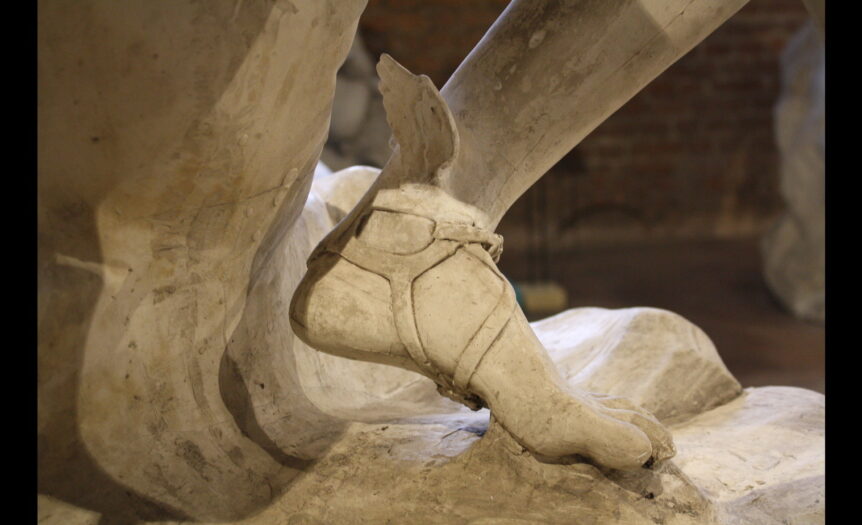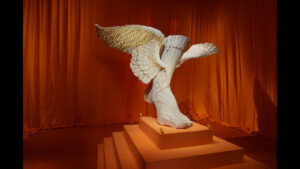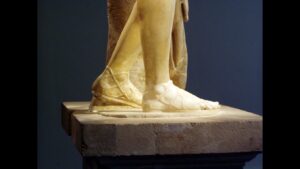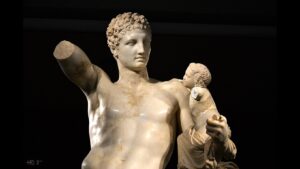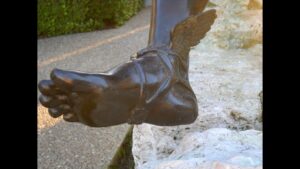In the mystical world of Greek mythology, one god stands out for his unique footwear – the winged sandals. These aren’t just any ordinary shoes, they’re a symbol of swift mobility and divine power. But dewa yunani mana yang memiliki sandal bersayap? Find out in this fun article.
Dewa Yunani Mana Yang Memiliki Sandal Bersayap
Hermes is the answer to the question, Dewa Yunani mana yang memiliki sandal bersayap? This Greek deity, known as the messenger of the gods, didn’t just dabble in delivering divine dispatches. He’s also recognized as the protector of travelers, guide to the Underworld, and patron of commerce, athletes, and thieves.
Hermes’ iconic winged sandals, called talaria in Greek, stand as a symbol of his swift mobility and unique divine mandate. Fashioned by the god of blacksmiths, Hephaestus, these sandals allowed Hermes to travel between worlds with unparalleled speed.
It’s worth mentioning that Hermes’ sandals were not just a functional tool – they also served as an important visual signifier in Greek mythology. When Greeks saw a depiction of a god with the winged sandals, they’d instantly know it’s Hermes they’re looking at. Detailed on the sides, these symbols subtly conveyed the essence of Hermes’ role—as the celestial courier, transporter of souls, and a guide to mortals.
Greek Gods and Myths
Greek mythology, a fount of timeless tales, still captures our imaginations with stories of heroism, vengeance, and love. This brings up questions like dewa yunani mana yang memiliki sandal bersayap? Greek gods and myths are not only narratives of old but also serve as a mirror to reveal timeless human emotions and desires.
Overview of Greek Mythology
Greek mythology is a corpus of ancient tales with deep roots in the culture of Greece. It’s filled with legends of titans, gods, demigods, and heroes whose exploits explain the natural world, the cosmogony, and provide moral lessons. These myths weren’t mere works of fiction – they were embedded in the fabric of society, influencing every aspect from religious rites to everyday customs.
Foremost among these myths are tales of the Olympians, the major deities of the Greek pantheon. Each Olympian ruled over a certain aspect of the physical and moral world. Loved and feared in equal measure, their stories continue to resonate with the intriguing blend of truth, morality, and mythology.
The God Hermes and His Winged Sandals
The god Hermes, renowned as the herald of the gods, stood out even among the intriguing members of the Greek pantheon. Known for his quick wit and swiftness, Hermes was entrusted with several important roles.
Hermes’ winged sandals, commonly known as talaria, were one of his most distinguishing attributes. These were no ordinary footwear. Crafted by Hephaestus, the divine blacksmith, the sandals were borne of immortality and endowed with the power to carry Hermes across vast distances with unmatched speed.
Hermes utilized the talaria in his capacity as the divine messenger, bridging the divine and mortal planes, and delivering decrees of the gods to humans. Without them, the interplay between gods and mortals may not have been as dynamic and engaging.
Hermes’ winged sandals were not mere accessories, but a statement of his divine virtues – speed, mobility, and adaptability. So, when asked ‘dewa yunani mana yang memiliki sandal bersayap?’, the answer unambiguously echoes Hermes. Unique to Hermes, the sandals embody the spirit of the messenger god – swift, reliable, and tireless.
Gold and resplendent, they marked Hermes’ presence, instantly signifying his arrival to carry messages, guide souls to the underworld, or protect travelers.
The winged sandals are an enduring symbol of Hermes’ multifaceted roles as the celestial courier, transporter of souls, and guide to mortals. They portray Hermes not just as a messenger, but also underscore his critical role as a conduit between the divine and mortal realms. As we delve deeper into Greek mythology, these sandals remind us of the fascinating interplay between divine will and mortal endeavor.
Greek Hero Perseus and His Sandals
Stepping away from the realm of the gods, it’s now time to turn our attention to the legendary heroes of Ancient Greece. This next segment focuses on the courageous hero Perseus and the story of his magical sandals.
Overview of Perseus in Greek Mythology
Perseus, a pinnacle of Greek heroic mythology, was the son of Zeus and Danae. He’s best remembered for his daring exploits, including one of the most famed: the beheading of Medusa. The tale of Perseus is fortunate – a string of challenging quests ending in triumph, painting a shining example of what it meant to be a Greek hero.
Unlike Olympus’s other inhabitants, Perseus was not a god but a demi-god, being the offspring of a mortal woman and Zeus himself. Although he did not possess the same indomitable strength as Hercules, another famous demi-god, Perseus was characterized by his cunning, bravery, and resourcefulness.
The Magical Sandals Given by Hermes
Enter Hermes, the dewa yunani mana yang memiliki sandal bersayap, or the Greek god known for his winged sandals. This divine figure plays an integral role in the bold saga of Perseus. When Perseus embarked on his mission to slay Medusa, it was Hermes who donated a unique tool to aid him: a pair of winged sandals.
In Greek mythology, these sandals, also known as “talaria,” had the ability to grant its wearer the power of flight, a significant advantage in combat and exploration. The moment Perseus put them on, he could travel at extreme speeds and distances, embodying the swift travel associated with the divine messenger god, Hermes.
It was with these sandals that Perseus was able to fulfill his destiny, successfully completing his daring missions. This narrative not only highlights the brilliant heroism of Perseus but also the keen characteristics and munificent nature of Hermes, one of the most revered gods in Greek mythology.
With the aid of the winged sandals, Perseus was able to transcend beyond the capabilities of normal men and engage in the fantastical. These sandals thus symbolize not only speed and agility but also transition and transformation – from ordinary to extraordinary, from mortal to semi-divine. They remind us once again of the fascinating interplay between mortal endeavor and divine intervention, presenting yet another mesmerizing story in the rich tapestry of Greek mythology.
In the sections to follow we’ll delve deeper into these heroic myths and their impact on Greek culture and society. So, be ready to immerse yourself into the magical world of Greek mythology, where gods and mortals mingle, and where heroic feats, as seen in the tales of Perseus, make for epic storytelling.
Sandals in Greek Mythology
In Greek mythology, shoes were not only used for protection and comfort. They were ingrained with symbolism and often held supernatural abilities. The iconic winged sandals – or talaria – are a prime example of such footwear. The wearer of these magical sandals was no other than Hermes, the messenger of the gods, himself. Let’s look more closely into the symbolism behind these mystical shoes and explore other Greek deities associated with sandals.
Symbolism Behind Winged Sandals
Hermes’ winged sandals symbolized more than just speed and agility. They were a representation of his divine power, of transcending both earthly and heavenly limitations and conveying messages between the gods and mortals. His winged sandals became the epitome of his transformative abilities, able to adapt and flourish in any circumstance. These sandals not only enabled him to travel instantly between realms but also embodied his qualities as the god of transitions, travelers, trade, language, and athletic contests. This symbolic footwear further emphasizes Hermes’ ties to intelligence, communication, and cunning.
Other Greek Gods and Goddesses Associated with Sandals
Although Hermes’ talaria are the most iconic sandals in Greek mythology, other gods and goddesses are also associated with distinctive footwear. You might see them when you ask dewa yunani mana yang memiliki sandal bersayap? For instance, Aphrodite, the Greek goddess of love, beauty, pleasure, and fertility, had sandals made of pure gold. These shoes, like her personality, radiated allure and charm and asserted her opulence and grandeur.
On the other hand, Athena, the goddess of wisdom, craft, and war, sported sandals decorated with the image of Medusa, symbolizing her victory over irrational fear. Athena’s sandals showcased her power, wisdom, and strategic warfare.
What You Need to Know About Dewa Yunani Mana Yang Memiliki Sandal Bersayap
So, it’s clear that the winged sandals of Hermes hold a significant place in Greek mythology. They’re more than just a symbol of speed or agility. They’re a testament to Hermes’ divine power, his role as a divine messenger, and his association with transitions, travelers, trade, language, and athletic contests. While other Greek deities like Aphrodite and Athena have their unique sandals, Hermes’ winged sandals remain iconic. These myths continue to influence Greek culture and society, proving their timeless relevance.

